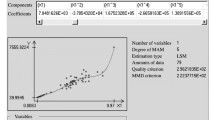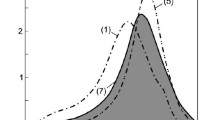Significant discrepancies in estimates of the Hubble constant are discussed in terms of the measurementproblem of calibrating the cosmological distance scale. It is shown that representing the Freedman–Robertson–Walker problem by a 3rd order Taylor expansion with respect to the criterion of minimal error inthe inadequacy is not optimal in terms of accuracy. An anisotropic 2nd order model based on the Heckmannrepresentation is more accurate.
Similar content being viewed by others
Notes
The protocol form (without rounding) is assumed for the estimates in this article. The accuracy characteristic for the models is taken to be the AMEI \( {\overline{\upvarepsilon}}_{\vartheta}^{\left[s\right]} \), where ϑ is the binary code for the model structure or the exponent on the highest power of the arguments in the Taylor series (MMS); [s] is the index for the structural-parametric identification algorithm in the scheme for overlapping observation of the inadequacy error with s = 1 corresponding to MMKMEDS and s = 2, to MMKMNK [12].
References
K. Lang, Astrophysical Formulas. Part 2 [Russian translation], Mir, Moscow (1978).
S. F. Levin, Optimal Interpolation Filtration of Statistical Characteristics of Random Functions in a Deterministic Version of the Monte-Carlo Method and the Red Shift Law, AN SSSR, NSK, Moscow (1980).
A. G. Riess et al., “Observational evidence from supernovae for an accelerating universe and a cosmological constant,” Astron. J., 116, 1009–1038 ( 1998).
A. G. Riess et al., “A 2.4% determination of the local value of the Hubble constant,” Preprint Astrophys. J., http://arXiv:1604.01424v3 [astro-ph.CO] 9 Jun 2016, acc. Feb. 24, 2017.
Planck Collaboration, “Planck intermediate results. XLVI. Reduction of large-scale systematic effects in HFI polarization maps and estimation of the reionization optical depth,” Astron. & Astrophys. Manuscr., http://arXiv:1605. 02985v2 [astro-ph.CO] 26 May 2016, acc. Dec. 31, 2017.
S. Alam et al., “The clustering of galaxies in the completed SDSS-III Baryon Oscillation Spectroscopic Survey: cosmological analysis of the DR12 galaxy sample,” http://arXiv:1607.03155v1 [astro-ph.CO] 11 Jul 2016, acc. Feb. 18, 2017.
M. Moresco et al., “A 6% measurement of the Hubble parameter at z ~ 0.45: direct evidence of the epoch of cosmic re-acceleration,” http://arXiv:1601.01701v2 [astro-ph. CO] 2 May 2016, acc. March 24, 2018.
R. L. Beaton, W. L. Freedman, B. F. Madore, et al., “The Carnegie-Chicago Hubble program. I. An independent approach to the extragalactic distance scale using only population II distance indicators,” http://arXiv:1604.01788v3 [astro-ph.CO] 11 Nov 2016, acc. Aug. 10, 2017.
W. L. Freedman, “Cosmology at a crossroads: Tension with the Hubble constant,” http://arXiv.org:1706.02739 13 Jul 2017, acc. Dec. 31, 2017.
S. F. Levin, “Identification of interpreting models in general relativity and cosmology,” in: Physical Interpretation of Relativity Theory: Proc. Int. Sci. Meeting PIRT-2003, Moscow, June 30–July 3, 2003, Coda, Moscow, Liverpool, Sunderland (2003), pp. 72–81.
G. Feldman and R. Cousins, “Unified approach to the classical statistical analysis of small signals,” Phys. Rev. D, 57, No. 7, 3873–3889 (1998).
G. Rosi, F. Sorrentino, L. Caccia-puoti, et al., “Precision measurement of the Newtonian gravitational constant using cold atoms,” Nature, 510, 518–521 (2014).
T. Quinn, H. Parks, C. Speake, and R. Davis, “Improved determination of G using two methods,” Phys. Rev. Lett., 111, 101102 (2013).
W. L. Freedman, B. F. Madore, B. K. Gibson, et al., “Final results from the Hubble space telescope key project to measure the Hubble constant,” Astrophys. J., 553, 47–72 (2001).
R 50.2.004-2000, GSI. Determination of the Characteristics of Mathematical Models of Relationships between Physical Quantities during Solution of Measurement Problems. Basic Assumptions.
W. L. Freedman, B. F. Madore, V. Scowcroft, et al., “Carnegie Hubble program: a mid-infrared calibration of the Hubble constant,” Astrophys. J., 758:24, Oct. 10 (2012).
O. V. Verkhodanov, Yu. N. Pariiskii, and A. A. Starobinskii, “Determination of ΩΛ and H 0 from photometric data on radio galaxies,” Byull. SAO RAN, 58, 5–16 (2005).
S. Perlmutter et al., “Measurements of Θ and Λ from 42 high-red shift supernovae,” Astrophys. J., 517, 565–586 (1999).
Planck Collaboration, “Planck 2015 results. XIII. Cosmological parameters,” Astron. & Astrophys., 594, A13 (2016).
M. Visser, “Jerk, snap, and the cosmological equation of state,” http://arXiv:gr-qc/0309109v4 31 Mar 2004, acc. April 8, 2017.
O. Heckmann, Theorien der Kosmologie, Springer, Berlin (1942).
S. F. Levin and A. P. Blinov, “Scientific-methodological support for guaranteed solution of metrological problems by probabilistic-statistical methods,” Izmer. Tekhn., No. 12, 5–8 (1988).
S. F. Levin, “The measurement problem of identifying red-shift anisotropy,” Metrologiya, No. 5, 3–21 (2010).
S. F. Levin, “Philosophical problems and statistical methods in fundamental metrology,” Metafizika, No. 3 (5), 89–118 (2012).
S. F. Levin, “Cosmological distance scale. Part 6. Statistical anisotropy of red shift,” Izmer. Tekhn., No. 5, 3–6 (2017).
S. F. Levin, “Statistical methods for the theory of measurement problems in cosmology,” Yad. Fiz. Inzhinir., 4, No. 9–10, 926–932 (2013).
B. P. Schmidt, “Accelerated expansion of the universe based on observations of distant supernovae,” Usp. Fiz. Nauk, 183, No. 10, 1078–1089 (2013).
RMG 29-2013, GSI. Metrology. Basic Terminology and Definitions.
GOST R ISO 16269-6-2005, Statistical Methods. Statistical Representation of Data. Definition of Statistical Tolerance Intervals.
M. V. Pruzhinskaya, Supernova Stars, Gamma-Bursts, and the Accelerated Expansion of the Universe: Auth. Abstr. Candid. Dissert. in Phys.-Math. Sci., Lomonosov Moscow State University, Moscow (2014).
R. Jimenez and A. Loeb, “Constraining cosmological parameters based on relative galaxy ages,” Astrophys. J., 573, 37–42 (2002).
S. F. Levin and B. S. Migachev, “The problem of selecting points for measurement monitoring during testing of means of measurement,” Izmer. Tekhn., No. 9, 69–72 (1998).
S. F. Levin, “The measurement problem of identifying the error function,” Zakonodat. Prikl. Metrol., No. 4, 27–33 (2016).
S. F. Levin, “The measurement problem of verifying the agreement between means of measurement and established specifications,” Kontr.-Izmer. Prib. Sist., No. 6, 27–33 (2016).
GOST 8.009–84, GSI. Normalized Metrological Characteristics of Means of Measurement.
MI 188–86, GSI. Means of Measurement. Establishing Values of the Parameters of Verification Methods.
Author information
Authors and Affiliations
Corresponding author
Additional information
Translated from Izmeritel’nayaTekhnika, No. 11, pp. 15–21, November, 2018.
Rights and permissions
About this article
Cite this article
Levin, S.F. Cosmological Distance Scale. Part 7. A New Special Case with the Hubble Constant and Anisotropic Models. Meas Tech 61, 1057–1065 (2019). https://doi.org/10.1007/s11018-019-01549-6
Received:
Published:
Issue Date:
DOI: https://doi.org/10.1007/s11018-019-01549-6




